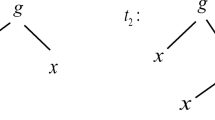Abstract
The propositional system of a general class of discrete deterministic systems is formally characterized. We find that any finite prime orthomodular lattice allowing two-valued states can be represented by an automaton logic.
Similar content being viewed by others
References
Birkhoff, B. (1948).Lattice Theory, 2nd ed., American Mathematical Society, New York.
Birkhoff, G., and von Neumann, J. (1936).Annals of Mathematics,37, 823.
Boskovich, R. J. (1755).De spacio et tempore, ut a nobis cognoscuntur, Vienna, 1755 [English translation, inA Theory of Natural Philosophy, Open Court, Chicago, 1922; reprinted by MIT Press, Cambridge, Massachusetts, 1966], pp. 203–205.
Brauer. W. (1984).Automatentheorie, Teubner, Stuttgart.
Conway, J. H. (1971).Regular Algebra and Finite Machines, Chapman and Hall, London.
Finkelstein, D., and Finkelstein, S. R. (1983).International Journal of Theoretical Physics,22, 753–779.
Giuntini, R. (1991).Quantum Logic and Hidden Variables, BI Wissenschaftsverlag, Mannheim.
Grib, A. A., and Zapatrin, R. R. (1990).International Journal of Theoretical Physics,29, 113–123.
Grib, A. A., and Zapatrin, R. R. (1992).International Journal of Theoretical Physics,31, 1669–1687.
Gudder, S. (1979).Stochastic Methods in Quantum Mechanics, North-Holland, Amsterdam.
Hopcroft, J. E., and Ullman, J. D. (1979).Introduction to Automata Theory, Languages, and Computation, Addison-Wesley, Reading, Massachusetts.
Kalmbach, G. (1983).Orthomodular Lattices, Academic Press. New York.
Moore, E. F. (1956). Gedanken-experiments on sequential machines, inAutomata Studies, C. E. Shannon and J. McCarthy, eds., Princeton University Press, Princeton, New Jersey.
Navara, M., and Rogalewicz, V. (1991).Mathematische Nachrichten,154, 157–168.
Pták, P., and Pulmannová, S. (1991).Orthomodular Structures as Quantum Logics, Kluwer, Dordrecht.
Rössler, O. E. (1987). Endophysics, inReal Brains, Artificial Minds, J. L. Casti and A. Karlquist, eds., North-Holland, Amsterdam, p. 25.
Rössler, O. E. (1992).Endophysics, Die Welt des inneren Beobachters, P. Weibel, ed., Merwe Verlag, Berlin.
Schaller, M., and Svozil, K. (1994).Nuovo Cimenta,109B, 167.
Svozil, K. (1983). On the setting of scales for space and time in arbitrary quantized media, Lawrence Berkeley Laboratory preprint LBL-16097.
Svozil, K. (1986a).Europhysics Letters,2, 83.
Svozil, K. (1986b).Nuovo Cimento,96B, 127.
Svozil, K. (1993).Randomness and Undecidability in Physics, World Scientific, Singapore.
Szász, G. (1963).Introduction to Lattice Theory, Academic Press, New York.
Toffoli, T. (1978). The role of the observer in uniform systems, inApplied General Systems Research, G. Klir, ed., Plenum Press, New York.
Author information
Authors and Affiliations
Rights and permissions
About this article
Cite this article
Schaller, M., Svozil, K. Automaton partition logic versus quantum logic. Int J Theor Phys 34, 1741–1749 (1995). https://doi.org/10.1007/BF00676288
Received:
Issue Date:
DOI: https://doi.org/10.1007/BF00676288




